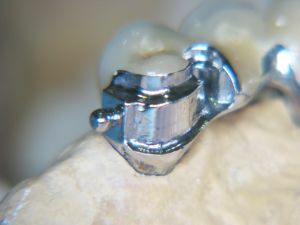 More recently, people with installed removable dentures have had problems fixing them, especially on the lower jaw. But everything changed with the appearance of attachments in the arsenal of dental prosthetists.
More recently, people with installed removable dentures have had problems fixing them, especially on the lower jaw. But everything changed with the appearance of attachments in the arsenal of dental prosthetists.
Attachments( attachments, attachment) are small fastenings( locks) used to fix various prostheses, are especially in demand in clasp prosthetics. Attachments are firmly attached to implants, artificial crowns or supporting teeth, thereby retaining the clasp prosthesis. Each lock of a similar construction consists of a male( inside) and a matrix( outer).
Reliable fixing allows you to not feel discomfort during the reception of food or during a conversation. The main factor in favor of using locks of this type is aesthetics and reliability.
Contents
- Design
- Features
- A variety of dental attachments
- Advantages and disadvantages of using the lock fixation attachment
- Clasp prosthetics - structural features
- The real situation
- Firms manufacturers
Design features
Attachment design is similar to the clothespin - one push securely connects two surfaces. By their appearance and design can be different, except for clasp prostheses, these elements are widely used for fixing dental bridges.
The lock fastener contains two elements. The first is attached to the crown of artificial material, the dental root or implant, and the second is attached to a removable prosthesis.
Fastening locks are created and strong casting, they are quite comfortable to wear in the mouth and they do not interfere in the process of food intake.
Have locks on the side of the tongue, which hides them from the foreign eye during meals and during the conversation. They are simple, reliable, aesthetic and characterized by a long period of operation.
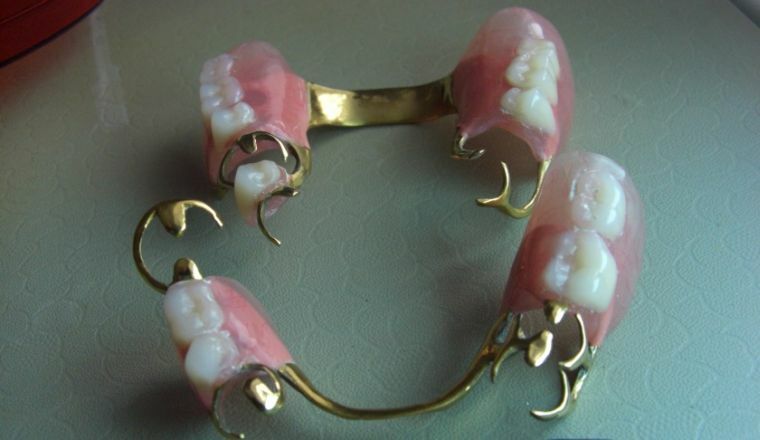
A variety of dental attachments
Attachments, depending on the method of creation, are divided into the following types:
- precision , which are made in the factory, have high accuracy, are attached to the prosthesis by welding;
- semi-precision are made in laboratories of metallic material, which is poured into special modeling impressions.
Given various types of defects in the oral cavity, when creating attachments use a variety of types of locks. If the defects in the dentition are minor, then rigid attachments will fit, but if the chewing teeth are completely absent, then labile structures are used.
Kinds of locks by type of fastening and construction:
- behind the crown - fastened by soldering to the outside;
- inside the crown;
- intra-root, which are attached to the root caps;
- articular - articulated;

- anchor - connected by a button or sphere;
- bolt - construction with small valve;
- is semi-labile, which allows the prosthesis to be vertically displaced;
- labile - for the movement of the prosthesis in all planes;
- beams - a thin bar that is attached between the crowns and enters the groove, which is specially created at the bottom of the prosthesis.
In modern dentistry, rail attachments are most often used. Their design is as follows: the lock serves as a support and is made on a dental crown, and a groove is attached from the side of the prosthesis, the installation of which is carried out vertically. In the groove is put a process, which is soldered to the edge of the structure. You can also use a lock inside the mouth.
If the prosthesis is attached to the dental root, it is better to use a button attachement. At the root put a pin, for which a spherical groove is used. Or instead, soldered to the process in the form of a ball, which serves as a mount inside the root.
Advantages and disadvantages of lock application attachment
Attachments have several advantages:
- aesthetic, they are absolutely not visible on the tooth;
- very comfortable, with their help you can easily put on and remove the prosthesis;
- serve as fixation and stabilization of the entire prosthetic construction;
- in the process of food intake, there is a uniform load on the supporting teeth and other areas of the jaw;
- is light and beautiful;
- tested in practice and having exceptionally positive feedback;
- in the presence of a strong lock;
- can easily be repaired if necessary, for example, replace worn parts;

- does not impair articulation;
- does not need to be removed before going to bed;
- chewing function is restored;
- does not cause pain, irritation, discomfort;
- does not fall out and mix;
- details are available in financial terms;
- replacement of locks passes quickly enough.
There are also drawbacks:
- requires a highly qualified specialist for manufacturing and installation;
- the price for the installation itself is quite high;
- to use dentures with such locks you need to sharpen healthy teeth for uniformity, beauty and convenience;
- locks quite quickly fail;The
- design suffices only for half a year, since the fixation elements are weak;
- plastic parts quickly deform and need constant replacement;
- supporting teeth must have a high crown to allow room for the installation of parts of the lock, they must be sharpened under an artificial crown, and occasionally removed.
Clasp prosthetics - design features
Clasp prosthesis on attachments is a prosthetic construction that gradually displaces plaque dentures. This is because they are securely and aesthetically attached, relieving the discomfort of people who use them.
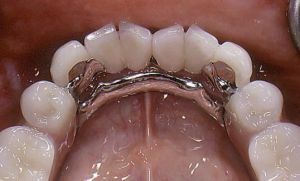 The bumper is a product that evenly distributes the load on the entire jaw, the frame of the structure consists of metal and an artificial crown, and the base of the prosthesis is attached to attachments.
The bumper is a product that evenly distributes the load on the entire jaw, the frame of the structure consists of metal and an artificial crown, and the base of the prosthesis is attached to attachments.
The arc made of metal is installed at the top and is thrown across the palate, and the second one, which is located below, passes behind the alveolar ridge at the bottom of the jaw.
Molded clasps create enveloping fasteners on the supporting teeth, making the stiffening hard, and in a single structure all parts of the prosthesis are fixed due to attachments that have 2 composite particles: the
- to the patricer, located on the implant, crown or dental root;
- matrix, which is located on the clasp, with which the attachment simply snaps into place, making the support secure and durable.
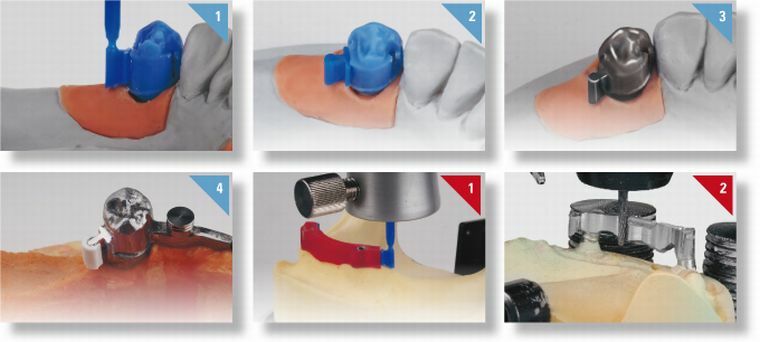
The process of manufacturing the prosthesis
The bug on the attachments( lock fastening) is characterized by a rigid type of stable fixation.
It is recommended to use clasp dentures with locks on locks only in the following cases:
- numerous teeth are destroyed;
- there are no roots;
- the process of chewing and articulation after tooth loss is disturbed;
- abnormal enamel erasure;
- strongly pronounced tubercles at the top of the jaw;
- in case of pronounced bruxism;
- teeth bent so that the plate prosthesis is hard to wear and remove;
- incorrect bite.
But there are also circumstances in which the use of attachments is strictly prohibited: 
- defects on supporting teeth;
- periodontal disease and periodontal disease;
- inflammation on the roots in the supporting teeth;
- low clinical crowns that have already been installed.
But if there are no contra-indications, then such fasteners are the best among others, as they are quite strong and qualitative.
The real state of affairs
Since prosthetics on the attachments are in great demand, there are many reviews of patients from dental clinics about them.
Recently installed a bugle with a lock in the mount. And I did it because I really wanted everything to look natural.
Of course, it was disappointing that they put metal ceramics on 4 teeth, which were absolutely healthy, but without this in any way. It is convenient to use the prosthesis, everything is perfectly fixed, there is no discomfort.
Semen, 39 years old.
Two years ago I lost a few teeth. Initially I wanted to put the implant, but it did not work out. And I was offered a prosthesis in dentistry for attachments.
I was very pleased, as everything was tightly fixed, nothing interfered with conversation and eating, everything looked very beautiful and natural.
Tamara, 44 years old
A month ago, I was fitted with a clasp design for the lower jaw, but discomfort appeared, the arch was pressing, it hurt to stir my tongue. Everything is swollen. But after the correction everything worked out, although I still can not get used to it.
Anna, 29 years
Firms manufacturers
The best laboratory for manufacturing clasp prostheses on attaches is AlvaDent. The production is in Russia, the whole production is made on equipment from Switzerland, so it is distinguished by quality and accuracy.
Ball attachments are made by Bredent, which is located in Germany and Rhein-83, which is located in Italy. They are used to fix prostheses.
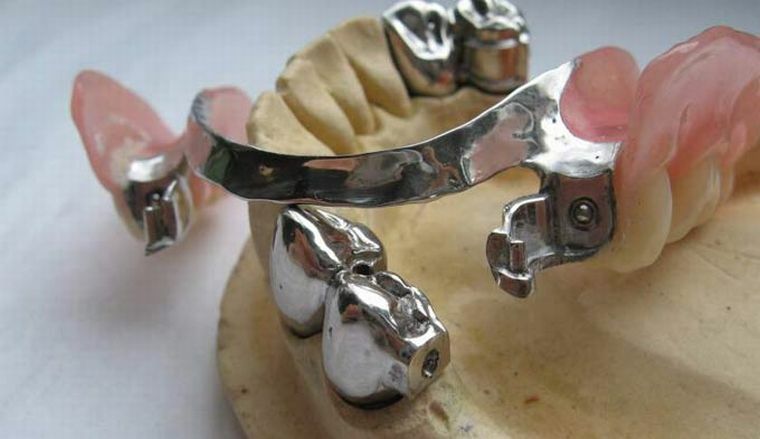
Fasteners from Bredent
Another company that specializes in the manufacture of locks and hinged fasteners is CENDRES &METAUX SA DENTAL, located in Switzerland. The company has developed the newest system of fasteners, which contains 6 variants of a matrix of a fastening and one patrician. The organization specializes in the production of rigid spherical, semi-labile, labile and girder attachments.
The German company Degussa also deals with the release of extracoronary, intracoronary, spherical and labile attachments.
Vertical lock from Rhein-83:
Price for dentures with attachments ranges from 100 to 1200 dollars. It all depends on the type of fasteners, their number and complexity of installation. This price includes not only the price of the goods themselves, but also diagnostics, manufacturing, fitting and installation.
